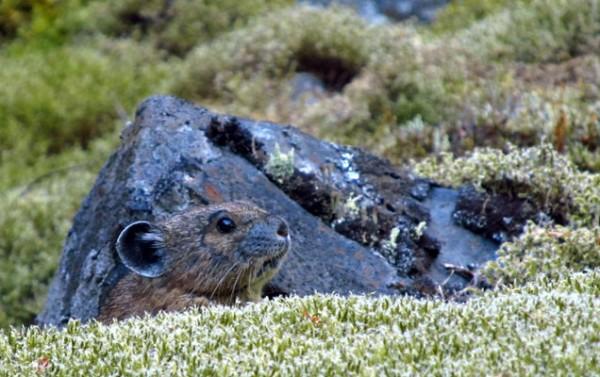【科学】杂志 动物篇 鼠兔为了活命吃苔藓

鼠兔要求并不高:有绿色植物啃着、有一个洞躲避老鹰、有凉爽的空气呼吸就够了。最后一个条件尤为重要,因为如果天气变得太热,气温超过26°C,这种胖乎乎的、囊地鼠大小的兔类动物就会死亡。由于全球变暖,鼠兔从美国西北太平洋沿岸的许多天然山区栖息地上消失了,留下来的鼠兔往往迁移到海拔更高的地区。但是,小群小群的鼠兔正在抗拒这种迁移的趋势,它们稳定地生活在山底部由积聚的落石形成的阴凉斜坡处。让人难以理解的是:下面可没有什么可吃的东西啊!现在,一项对其饮食的新研究揭示了生活在低处的鼠兔所吃的食物:它们赖以维持生计的食物是苔藓。几乎没有任何食草动物乐于吃苔藓,因为苔藓大都是粗纤维,比白纸的营养高不了多少。今天,研究小组在《哺乳动物学杂志》上报道说:然而,俄勒冈州哥伦比亚河谷地区的鼠兔有60%的饮食靠苔藓。为了挤出所有的营养,它们将苔藓以“盲肠营养素”的形式排泄出来,这种营养素包含从六倍多的苔藓中提炼出蛋白质,然后它们再把营养素吃进去,重新消化……秘密揭开了。
The pika does not ask for much. Something green to nibble on, a hole to hide from hawks, and cool air to breathe. Especially that last one, because the chubby gopher-sized relative of rabbits overheats and dies in temperatures greater than 26°C. Thanks to global warming, the pika has disappeared from many of its natural mountain habitats in the U.S. Pacific Northwest, and those that remain tend to migrate to higher elevations. But pockets of pikas are bucking that trend by living stably in shady talus slopes, the accumulated rockfall debris at the base of mountains. The mystery is that there is very little to nibble on down there. Now, a study of the diet of these lowland pikas reveals the food that allows them to eke out a living: moss. Very few herbivores bother with moss because it is mostly rough fiber with not much more nutrition than paper. But the pikas in Oregon’s Columbia River Gorge rely on it for 60% of their diet, the team reports today in the Journal of Mammalogy. To squeeze out every bit of sustenance, they poop the moss out in a form called caecal, which concentrates protein from the plant sixfold. Then they eat it and redigest it. Mystery solved.
译自:美国《科学》杂志网站(17 December 2013 5:00 pm)
原著:JOHN BOHANNON
译文:http://article.yeeyan.org/view/251964/394352






 京公网安备 11010802032529号
京公网安备 11010802032529号